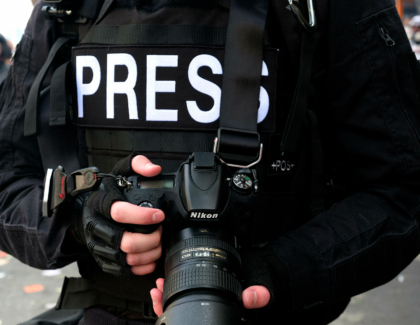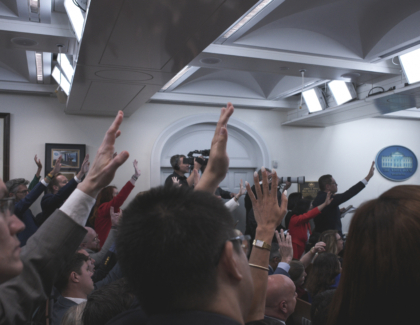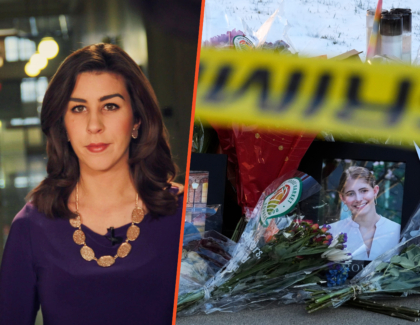Sign up for the daily CJR newsletter.
As the fallout from the guilty plea of longtime Trump lawyer Michael Cohen and the conviction of former Trump campaign chairman Paul Manafort continued to lead most national news outlets, the White House attempted to turn the focus to Iowa.
On Tuesday, around the same time the Cohen and Manafort news was breaking, authorities in Brooklyn, Iowa, charged Cristhian Bahena Rivera with the murder of Mollie Tibbetts, a 20-year-old college student who had been missing for more than a month. The president quickly seized on the story at a West Virginia rally that evening, the White House put out an emotional video on Wednesday afternoon, and Press Secretary Sarah Sanders began yesterday’s briefing with a statement about the murder. Why did the killing of a young woman garner so much attention from the administration? Because Rivera, according to law enforcement, is an undocumented immigrant.
The president’s hardline immigration stance is grounded in the false belief that undocumented immigrants represent a clear and present danger to American citizens, and Tibbetts’s murder fits the narrative that has been a hallmark of Trump’s rhetoric since the first moments of his campaign. The case received prominent play on Fox News, and its connection to the immigration debate was quickly picked up by pro-Trump pundits. Rivera’s lawyer has since claimed that his client was in the country legally, though it is unclear whether that’s true.
RELATED: Covering a country where race is everywhere
All of the attention transformed a tragic story into a political football. Mainstream outlets, which under normal circumstances likely wouldn’t have dedicated significant resources to the murder, were drawn into the fray, with The New York Times providing a case study in how outside forces shape coverage. The Times initially ran a straight news story on the charges against Rivera, highlighting his reported illegal status and mentioning only in the fourth paragraph that Trump had driven attention to the story. The piece was later changed to reflect the president’s role in the case, and an update now sits atop the story, directing readers to an analysis of the way Tibbetts’s murder has been used by Trump and covered in conservative media.
The manner in which changes were made to the Times’s story, with no notice to readers that the piece had been significantly altered, reignited concerns about “stealth editing,” a practice that NYT Public Editors have repeatedly criticized in the past. In an email, Philip Corbett, the associate managing editor for standards at the Times, writes, “We edit, revise and update stories all the time, all day and often all night—probably dozens of stories a day are revised in some way after initial publication, many of them multiple times. The point is to give readers at any given time the best-edited, clearest, most complete and most up-to-date story we can.” In this case, however, readers who only saw the first version of the story would have walked away lacking a clear understanding of the role that outside forces—from the president to conservative media—played in making the story worthy of the Times’s attention in the first place.
Immigration policy, from the travel ban to the wall to family separations, has been perhaps the most divisive and racially animated issue of Trump’s presidency. To properly cover Mollie Tibbetts’s murder and to help audiences understand why her death is being given so much attention by the administration, news outlets must provide context. USA Today’s Alan Gomez offered an example of what that kind of reporting looks like, addressing the conservative media frenzy that erroneously casts immigrants as dangerous while providing concrete evidence to explain that immigrants commit fewer crimes than native-born Americans. It’s vital that this kind of reporting be presented alongside coverage of these sort of cases. Mollie Tibbetts’s death is a tragedy, but media outlets don’t have to participate in the administration’s efforts to deploy it as a political cause that demonizes an entire group.
Below, more on the coverage of Tibbetts’s murder.
- Exploiting a killing: Politico’s Natasha Korecki and Quint Forgey write, “Every indication Wednesday was that the Tibbetts tragedy would be used to bolster the president’s argument and drive his message about border security this fall.”
- Trump speaks: The president posted a video to Twitter on Wednesday evening in which he argued that Tibbetts’s murder is an example of why a border wall with Mexico is needed.
- What’s at stake: The Atlantic’s Peter Beinart ties together Tuesday’s stories, writing that what Trump’s supporters “fear most isn’t the corruption of American law; it’s the corruption of America’s traditional identity. And in the struggle against that form of corruption—the kind embodied by Cristhian Rivera—Trump isn’t the problem. He’s the solution.”
Other notable stories
- The Washington Post’s Margaret Sullivan writes that the conviction of Paul Manafort and the guilty plea by Michael Cohen—in which the president’s former lawyer implicated Trump in campaign finance violations—are the moment Trump’s media attacks have been meant for. “In a divided, disbelieving nation, will this really turn out to be the epic moment it looks like?” Sullivan asks. “Or will Trump’s intense, years-long campaign to undermine the media—and truth itself—pay off now, in the clutch?”
- President Trump has come up with a number to quantify just how much of the media is “the enemy of the people.” In an interview aired Thursday morning, he tells Fox & Friends’ Ainsley Earhardt that 80 percent of the press is “fake news.”
- “The federal campaign finance and tax evasion case that is embroiling the White House began in the unlikeliest of places: the world of supermarket tabloids,” write the Times’s Jim Rutenberg and Rebecca R. Ruiz in their look at the role American Media Inc. played in helping Trump cover up stories that might hurt his campaign.
- As part of The New York Times’s homepage redesign, author bylines have disappeared. Politico’s Jack Shafer makes a persuasive case that this is a bad idea, one that doesn’t help readers and runs counter to the paper’s recent trend of promoting its star journalists.
- For CJR, Tamar Wilner profiles Dallas NPR show Anything You Ever Wanted to Know, a program that “defies the ‘Google it’ age.”
- CNN has suspended pro-Trump pundit Paris Dennard after The Washington Post’s Aaron C. Davis reported that Dennard had been fired from a position at Arizona State University four years ago for making sexually explicit comments and gestures toward women.
ICYMI: Facebook has a trustworthiness score for you, but it’s top secret
Has America ever needed a media defender more than now? Help us by joining CJR today.







